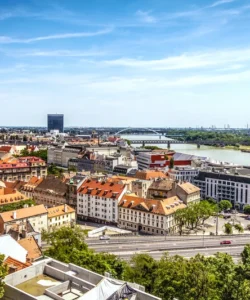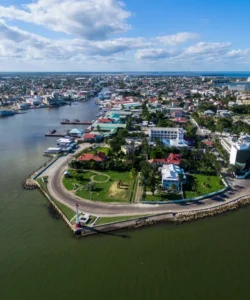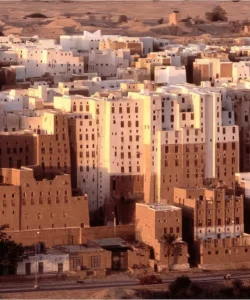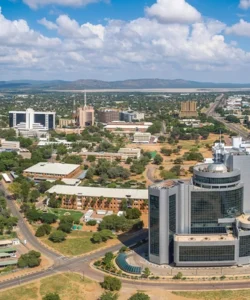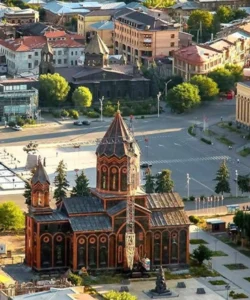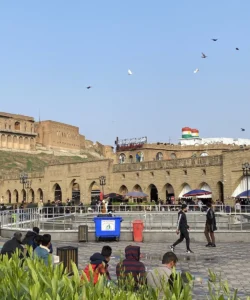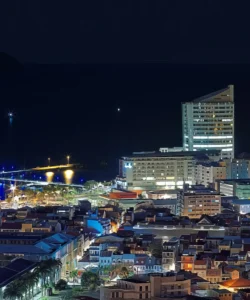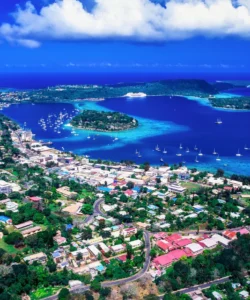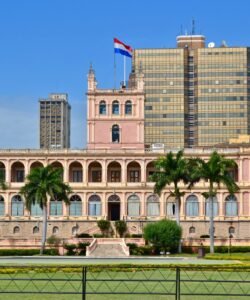Bosnia and Herzegovina (often abbreviated as BiH) is a country in Southeast Europe, located in the western Balkans. It is known for its diverse cultural and religious heritage, stunning natural beauty, and a complex history marked by both Ottoman and Austro-Hungarian influences.
Listen to an introduction about Bosnia and Herzegovina
![]()
Area and Population:
Bosnia and Herzegovina covers an area of approximately 51,209 km² (19,772 sq mi). As of early 2025, its population is estimated to be around 3.2 million.
Capital:
The capital city of Bosnia and Herzegovina is Sarajevo.
Major Cities:
Besides Sarajevo, other major cities include Banja Luka, Mostar, Tuzla, and Zenica.
Language:
Bosnia and Herzegovina has three official languages, which are mutually intelligible and derive from Serbo-Croatian:
- Bosnian
- Croatian
- Serbian
All three are recognized, and their usage often correlates with the country’s ethnic groups (Bosniaks, Croats, and Serbs, respectively). English is increasingly spoken, especially in tourist areas and among younger generations.
Currency:
The official currency of Bosnia and Herzegovina is the Convertible Mark (BAM). It is pegged to the Euro at a fixed rate of 1 EUR = 1.95583 BAM.
Religion:
Bosnia and Herzegovina is religiously diverse. The largest religious groups are:
- Islam: Predominantly practiced by Bosniaks.
- Orthodox Christianity: Predominantly practiced by Serbs.
- Roman Catholicism: Predominantly practiced by Croats.
Smaller communities of other religions, including Judaism, also exist. The country is known for its unique coexistence of these different faiths.
Attractions and Wonders:
- Stari Most (Old Bridge), Mostar: A magnificent 16th-century Ottoman bridge, a UNESCO World Heritage site, famous for its elegant arch and the traditional diving competition from its peak. It’s a powerful symbol of reconciliation.
- Baščaršija (Old Bazaar), Sarajevo: The historic and cultural center of Sarajevo, with cobblestone streets, artisan shops (coppersmiths, jewelers), traditional restaurants, and coffee houses.
- Latin Bridge, Sarajevo: A historic Ottoman bridge, famous as the site of the assassination of Archduke Franz Ferdinand, which triggered World War I.
- Gazi Husrev-beg Mosque, Sarajevo: A beautiful 16th-century Ottoman mosque, one of the most important Islamic structures in the Balkans.
- Vrelo Bosne (Spring of the Bosna River), Sarajevo: A beautiful natural park with springs, waterfalls, and walking paths.
- Tunnel of Hope, Sarajevo: A secret tunnel built under the airport runway during the Siege of Sarajevo, now a museum providing a poignant insight into the city’s wartime resilience.
- Blagaj Tekke (Dervish Monastery), near Mostar: A stunning monastery built into a cliff face at the source of the Buna River, a tranquil and picturesque spiritual site.
- Kravica Waterfalls, near Ljubuški: A series of beautiful tufa waterfalls on the Trebižat River, popular for swimming and relaxation in summer.
- Jajce: A historic town famous for its impressive fortress and the unique Pliva Waterfall, where the Pliva River plunges into the Vrbas River in the town center.
- Sutjeska National Park: The oldest and largest national park in BiH, home to Perućica, one of Europe’s last remaining primeval forests, and the highest peak, Maglić.
- Višegrad Bridge (Mehmed Paša Sokolović Bridge): A 16th-century Ottoman bridge over the Drina River, a UNESCO World Heritage site, immortalized in Ivo Andrić’s Nobel Prize-winning novel “The Bridge on the Drina.”
- Počitelj: A well-preserved medieval fortified village and open-air museum with Ottoman-era architecture.
Architecture:
Bosnia and Herzegovina’s architecture tells the story of its multi-layered history, featuring distinct influences:
- Ottoman: Predominant in old towns like Sarajevo’s Baščaršija and Mostar, characterized by stone bridges (Stari Most), mosques, traditional houses (kujundžiluk, konak), and hammams (bathhouses).
- Austro-Hungarian: Introduced during the late 19th and early 20th centuries, this style brought grand public buildings, boulevards, and more structured residential areas, particularly evident in central Sarajevo and parts of Mostar, with Secessionist and Neo-Baroque elements.
- Medieval: Fortresses and castles (e.g., Jajce Fortress, Počitelj, Ostrožac Castle) scattered across the country.
- Socialist Realism/Brutalism: Remnants from the Yugoslav era, characterized by large, often stark concrete structures, especially visible in some residential areas and monuments (e.g., the Skenderija Center in Sarajevo).
- Contemporary: Post-war reconstruction and modern development have introduced contemporary architectural styles, often blending with traditional elements.
Roads:
Bosnia and Herzegovina’s road network has seen significant improvements, especially on main arteries, but can still vary in quality, particularly in rural and mountainous areas.
- Motorways (Autoceste – A-roads): A developing network of modern motorways, with the A1 being the most significant, connecting Sarajevo with Zenica and a section towards Mostar. These are generally well-maintained and tolled.
- Main Roads (Magistralne ceste – M-roads): A comprehensive network of main roads connects cities and towns. While many sections are in good condition, others can be winding, narrow, and less well-maintained, particularly in mountainous terrain.
- Regional Roads: Smaller, often unpaved or poorly maintained roads in remote areas.
- Mountain Passes: Numerous scenic but challenging mountain roads and passes exist, requiring careful driving, especially in winter due to snow and ice.
- Signage: Road signs are generally clear, using Latin script predominantly.
Driving requires caution due to varied road conditions and sometimes aggressive driving habits, but the network allows for comprehensive exploration of the country.
Hotels:
Bosnia and Herzegovina offers a range of accommodation options, from international standard hotels to charming boutique properties and guesthouses.
- International Chains: Major cities like Sarajevo and Banja Luka have international hotel brands (e.g., Novotel, Marriott, Courtyard by Marriott).
- Boutique Hotels: Especially in the historic centers of Sarajevo and Mostar, charming boutique hotels offer character and local flair.
- Traditional Guesthouses (Pansions/Konaks): In old towns, these offer an authentic experience, often family-run with traditional decor and hospitality.
- Apartments and Holiday Rentals: A popular choice, especially for longer stays or groups.
- Budget Accommodation: Hostels are available in major tourist hubs.
- Mountain Lodges and Resorts: In areas like Bjelašnica and Jahorina (popular ski resorts), offering accommodation for winter sports and summer activities.
Restaurants and Cuisine:
Bosnian cuisine is a delicious fusion of Turkish, Middle Eastern, Central European, and Balkan influences, characterized by rich flavors, slow cooking, and the use of fresh, local ingredients.
- Ćevapi: Small, grilled minced meat sausages (usually beef or lamb, or a mix), served in a flatbread (somun or lepinja) with chopped onions and kajmak (creamy cheese spread) or ajvar (red pepper relish). A quintessential Bosnian dish.
- Burek: A savory pastry made with thin, flaky dough, traditionally rolled into a spiral or layered, and filled with minced meat (the only true “burek” to Bosniaks), cheese (sirnica), spinach and cheese (zeljanica), or potatoes (krompiruša). A popular fast food.
- Bosanski Lonac: A traditional Bosnian pot stew, typically containing large chunks of meat (beef, lamb) and various vegetables (cabbage, potatoes, carrots, tomatoes), slow-cooked in a clay pot.
- Sarma: Minced meat and rice wrapped in pickled cabbage leaves, slow-cooked in a flavorful sauce.
- Filovane Paprike: Bell peppers stuffed with minced meat and rice.
- Begova Čorba (Bey’s Soup): A rich and creamy chicken and vegetable soup, often thickened with okra.
- Hadžijski Ćevap: A pan-fried beef dish with onions, mushrooms, and spices.
- Pljeskavica: A seasoned meat patty, similar to a hamburger, often served with bread and condiments.
- Kajmak: A creamy, clotted dairy product, often served with bread or alongside grilled meats.
- Ajvar: A relish made from roasted red peppers, often with eggplant.
- Desserts:
- Baklava: Layers of phyllo pastry filled with nuts and sweetened with syrup.
- Tufahija: Walnuts stuffed in poached apples, topped with whipped cream.
- Hurmašice: Small, syrup-soaked cakes.
- Drinks:
- Bosnian Coffee (Kafa): Traditionally prepared and served in a džezva (copper pot) with a small cup (fildžan) and Turkish delight.
- Rakija: A strong fruit brandy, common throughout the Balkans.
- Local Wine: Production is primarily from Herzegovina (e.g., Žilavka for white, Blatina for red).
- Beer: Local breweries produce popular lagers.
Dining experiences range from traditional “aščinicas” (local eateries serving cooked dishes) and “ćevabdžinicas” (specializing in ćevapi) to more modern restaurants offering international cuisine, especially in Sarajevo.

